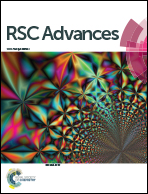Ionic liquids as potentially new antifungal agents against Alternaria species†
Abstract
The fungal genus Alternaria Nees 1816 includes the most prevalent pathogenic species that can cause crop diseases such as blight, black spot, and dark leaf spot. In accordance with the aim of developing modern sustainable approaches in agriculture for the replacement of synthetic and toxic substances with environmentally friendly alternatives, the objective of this study was to examine the in vitro antifungal activities of 18 newly synthesized ionic liquids (ILs) against three Alternaria strains: A. padwickii, A. dauci and A. linicola. The antifungal activities of the ILs were estimated via a microdilution method to establish minimal inhibitory concentration (MIC) and minimal fungicidal concentration (MFC) values. The results confirmed that 17 of the 18 ILs showed strain specificity, including good antifungal activity toward Alternaria strains, with MIC and MFC values in the range of 0.04 to 0.43 mol dm−3. The strongest antifungal effects toward all analyzed Alternaria strains were displayed by the compounds with long alkyl chains: [omim][Cl] (MIC/MFC: 0.042 mol dm−3), [dmim][Cl] (MIC/MFC: 0.043 mol dm−3), [ddmim][Cl] (MIC/MFC: 0.053 mol dm−3), [ddTSC][Br] (MIC/MFC: 0.053 mol dm−3), and [Allyl-mim][Cl] (MIC/MFC: 0.054 mol dm−3). The introduction of oxygen as a hydroxyl group resulted in less-pronounced toxicity towards Alternaria compared to the introduction of an ether group, while the contribution of the hydroxyl group was shown to be a more determining factor than the prolongation of the side-chain, resulting in overall fungicidal activity decrease. Our results indicate the possibility that the most effective ILs ([Allyl-mim][Cl], [omim][Cl], [dmim][Cl], [ddmim][Cl], [bTSC][Br], [hTSC][Br], [oTSC][Br], [dTSC][Br], and [ddTSC][Br]) could be applied to the control of plant diseases caused by Alternaria species, based on their potential as an environmentally friendly crop protection approach. Since salts based on TSC cations are significantly cheaper to synthesize, stable under mild conditions, and environmentally friendly after degradation, thiosemicarbazidium-based ILs can be a suitable replacement for commercially available imidazolium ILs.



 Please wait while we load your content...
Please wait while we load your content...